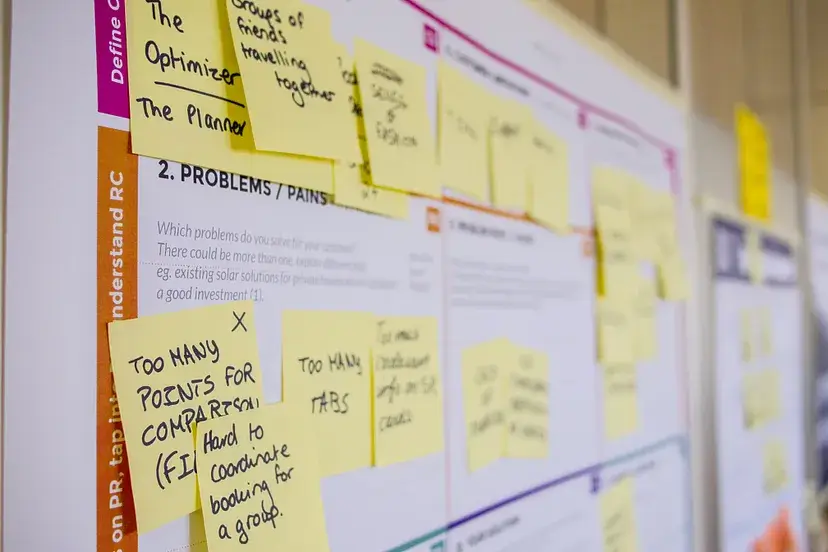Introduction
Have you been in a class or a speech where the speaker is not able to tell the exact point he wants to make, it is because he has not planned his speech before coming to stage. The same is the case with the UX research study.
Planning a UX research study can help ensure your project goes more smoothly. A UX research plan helps to set expectations and documents the essentials you need to communicate to stakeholders or clients.
To successfully plan a research study you need to make a UX Research plan.
What is a UX Research Plan?
UX research plan gives an overview of the project’s timeline, goals, participants, and objectives. It contains elements like project background, research goals, research questions, KPIs, methodology, participants, and script.
A research plan helps in keeping the team on track and ensuring that the goals are met by the research study.
Why do we need to plan a UX Research Study?
There are numerous benefits of planning a UX research, including:
- Provides reference – The research plan provides an easy reference to the goals of the study and keeps the entire team in a single basket to prevent everyone from switching the goal of the research in the middle by mistake.
- Achieve your UX goals – A research plan helps you and your team to stay focused and on track.
- Engage stakeholders – A written plan is a great way to share research goals, methodology, etc to share with stakeholders and involve them in the research project.
7 essential elements for planning a UX Research Study
- Project Background
- Research Goals
- Research Questions
- KPIs
- Methodology
- Participants
- Script
We will go through each one in detail and see how to add them to your research plan.
Project Background
The project background summarizes the situation leading to the needs of the research study. It’s a brief explanation of “What led you to conduct the research?”
Establishing a project background gets the team on the same page before conducting the study and ensures everyone in the team has a common grasp of the history of the project.
Research Goals
Research goals is a brief explanation of “Why you are conducting the research?”. It describes specific ideas that you want to learn from the research or what outcomes you want from the research. Essentially, they drive the entire research study.
Research goals answers question like:
- What design problems are you trying to solve?
- How will the results of the research impact our design decisions?
Use the answers to create goals for your project.
Research goals will tell stakeholders what are you trying to achieve through the study, and how it will help them make decisions for the project.
Research Questions
Research questions are a brief explanation of “What questions are you trying to answer with the research study?”. It is the collection of questions you plan to answer during the study. These are not the questions you ask research participants. Instead, the research questions are the questions you want your research to answer and they should perfectly align with the research goals.
A good question will be:
- Actionable – You should be able to identify a clear way to attempt to answer the question.
- Specific – Make sure your research questions are specific and not too broad. This can prevent you from getting meaningful data.
- Non-leading – Questions should be neutrally phased so that they don’t sound like you are assuming a particular answer to your question.
KPIs
KPIs or Key Performance Indicators, give you a quantitative way to measure progress over time, see if the goals are being met, and analyze whether changes need to be made.
Key Performance Indicators are critical measures of progress toward an end goal. They are used to measure the effectiveness of your product or prototype.
KPIs are measured to track the progress, identify key problem areas, and show success to stakeholders.
You can find more about the KPIs used in UX research in this article:
Methodology
Now, we will progress from the background plans and move more towards our specific goal of the research study. The methodology describes the steps you use to conduct the research. It will list the procedure you will use while collecting the information.
There are two reasons to include methodology in your research plan, First, Methodology informs stakeholders what will happen during the study, how long the study is, and where it will take place, and second, Including methodology in your research plan will give stakeholders more confidence in your study results.
While thinking about the methodology it’s important to consider:
- The type of research method involved
- The steps involved in the research method
- The type of data that will be generated from the research method
Participants
This is an important plan for your research plan, consider this as the base of the study. The participants you select for the study will represent the voice of real users. Hence, you need to select study participants carefully. Having not an end-user participant can destroy the whole research study.
Things to keep in mind while selecting participants for your research study:
- Participant’s characteristics – Your research plan should include the primary characteristics of the people who will participate in the study and it should be based on your research goals.
- Screener survey – You should create a survey form with a series of questions that you will ask potential participants to see if they meet your desired characteristics.
- Incentives – You should give your participants some incentives for participating in the study.
- Diverse perspectives and abilities – Having a diverse set of participants can let you know about the needs of different groups of people which you didn’t think of in the first place. You should also include participants with physical impairments.
Including participants in your research plan will inform stakeholders of the potential users who will use the app and help your team align the goals according to the users.
Script
The script in the UX research plan is like an interview guide for your research session. It contains questions to ask participants and prompts or triggers them to complete. This guide is helpful to be used during user interviews, field studies, or face-to-face sessions.
During interviews, the script reminds you which questions to ask the participant and keeps the session on track.
For a Moderated research the script might include the prompts or triggers you’ll be sending your participants to complete.
For Unmoderated research – the script might consist of:
- Introduction – Short message you’ll say to participants before the session begins, it’s like a conversation starter.
- Questions – Includes questions you’ll ask your participants during the interview.
- Wrap-up – Finally the message to say at the end of the session, like, asking the participants if they are open to future research and thanking them for their time.
If you want to know more about moderated and unmoderated usability studies, check out this article
Conclusion
Having a research plan in hand is very helpful during your research study. It helps your study to go more smoothly and gets the whole team on the same page. It helps you to communicate more effectively with stakeholders. Lastly, It is an essential part of the UX research study.


